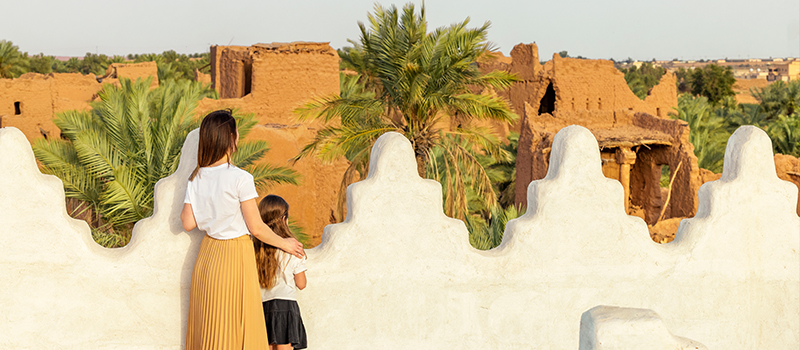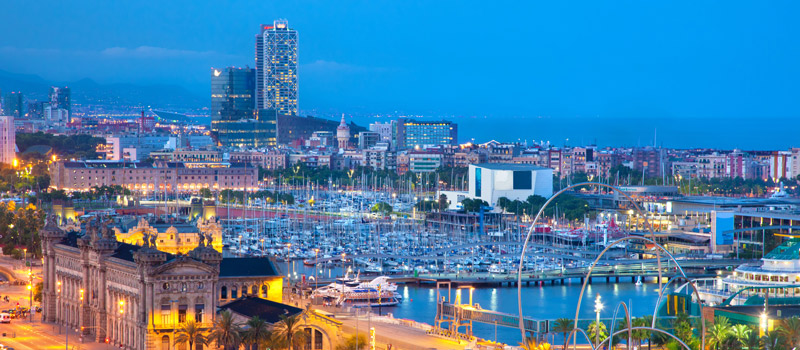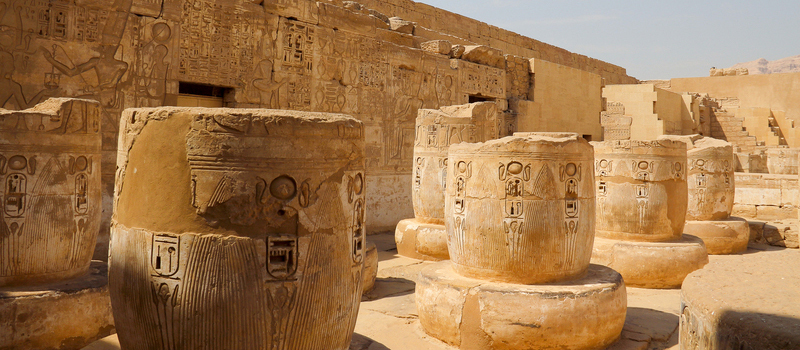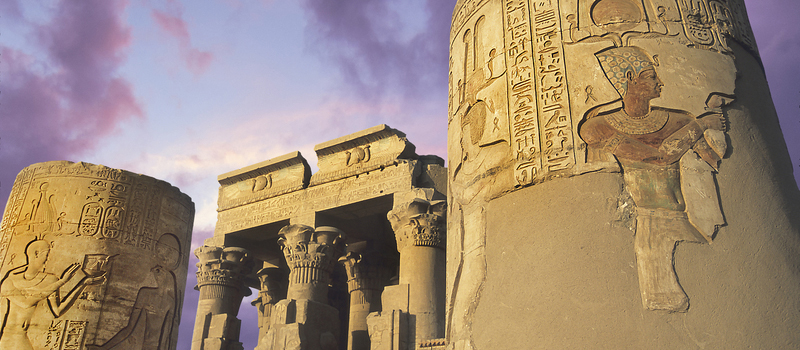Riyadh, the capital of Saudi, began as a small desert village surrounded by fences in the 17th century; by the 20th century, it had become a thoroughly modern metropolis. Riyadh’s blend of medieval and millennial makes for a beguiling cultural union — one where Arabia’s first roots can be traced, and where its bold future can be envisioned. The city’s fascinating, centuries-old history can be found within its atmospheric souqs, compelling museums, and ancient architecture, but it’s also a modern metropolis with glittering high-rises and a burgeoning contemporary art scene. The winter months are an ideal time to visit Riyadh.
Souqs: These markets are found in many Arab countries. In the past, they were open-air marketplaces where merchants could set up and sell their wares to travelers, and where people could gather together and socialize. They sell all manner of items such as souvenirs, perfumes, carpets, clothing, fabric, shoes, leather, jewelry, spices, and more. In Riyadh, there are many of these marketplaces. Souq Al Zal started in 1901 and is still a good place for tourists to have the souq experience. One can find traditional Saudi items such as mabkhara incense burners, and dallah coffee pots.
Museums: A perfect place to get firsthand knowledge of the history and culture of a destination is in its museums. There are many found in Riyadh, but the Saudi National Museum is one not to be missed. This has more than 3,700 antiquities on display in eight galleries and covers more than 1,000 years of Arabian history. One can find prehistoric skeletons, neolithic rock art, manuscripts, centuries-old crafts, interactive exhibits, and more. There is even a meteorite from the Rub Al Khali desert!
Architecture: There are many fine examples of historic architecture found in Riyadh. Noteworthy among these is the Al Masmak Fortress, which is a relatively recent structure. Built in 1865, it was captured by King Abdulaziz in 1902. King Al Saud took control of Riyadh and conquered the kingdoms and provinces, uniting them and forming the Kingdom of Saudi Arabia in 1932. The fortress, made of clay and mud-brick, is now a museum containing maps and photographs from the early 20th century, historical artifacts, artworks, and audiovisual presentations. And it happens to be located next to the previously mentioned Souq Al Zal.
Shopping Centers: At 300 meters (984 feet), the Kingdom Center is Riyadh’s fourth-tallest tower and perhaps the most luxurious. It contains high-end stores, restaurants, cinemas, a mosque, and the Sky Bridge observation deck. Located on the 99th floor, this alone is worth a visit for its mesmerizing views of the entire city and beyond.
Restaurants: Another great way to experience a destination is through its cuisine. Riyadh has many great eateries. The Nadj Village combines Saudi dining and heritage. Its architecture faithfully recreates a traditional town, and heirloom recipes passed down through generations lend authenticity to the cuisine. Kabsa (meat and rice), jareesh (a porridge dish of meat, tomatoes, and caramelized onions), and hashi (camel meat) are examples of some of the foods here. Two contemporary restaurants worthy of note are Takya and Suhail. Takya features fusion blends of different regions of Saudi. Sharing dishes is highly recommended—they advise five or six dishes to be shared between two people. Lamb Hasawi Rice (lamb slow cooked with wild grain rice), Sleeg (creamy rice infused with yogurt and sauteed chicken) and Kabuli Rice (chicken roulade with basmati rice) are menu items here. Suhail features traditional, authentic Saudi food served in a modern environment. Riyadh Jareesh (previously mentioned), Lamb Kabsah (fresh lamb and rice), and Kbab Miro Hijazi (fried camel and lamb meatballs with tahini sauce) are menu items here. It should be noted that both restaurants have vegetarian options as well.
Arts Scene: Saudis hope that one outcome of Vision 2030, the plan for economic development and diversification, will be an expansion of the art scene. The government, together with the private sector, is projected to invest billions into cultural infrastructure over the next 10 years. The Ministry of Culture was created in 2018 and will launch 11 agencies focusing on music, museums, and the performing arts. The Ministry of Tourism further expands these efforts through investments and multilateral cooperation. Riyadh will be at the center of the new art scene. The goal of Riyadh Art, the first Saudi public art initiative, is to transform Riyadh into “a gallery without walls.” The Riyadh Icon (an artistic symbol for Riyadh), Noor Riyadh (a city-wide festival of light and art), and the Tuwaiq International Sculpture Symposium (20 sculptors from around the world producing permanent public sculptures) are three vital parts of Riyadh Art. Galleries such as the Naila Art Gallery further contribute to Riyad’s burgeoning arts scene.
Central Holidays can assist you in getting the most out of your time in Riyadh. It has designed travel packages that explore all the city has to offer and has a professional staff that can help ensure that your travel experience is everything you desire.




.png)

 Multi Country
Multi Country  Italy
Italy  Spain
Spain  France
France  Greece
Greece  Portugal
Portugal  Croatia
Croatia  Malta
Malta 
 Saudi
Saudi  Egypt
Egypt  United Arab Emirates
United Arab Emirates  Israel
Israel  Jordan
Jordan  Oman
Oman  Eastern & Southern Africa
Eastern & Southern Africa 
 Argentina
Argentina  Bolivia
Bolivia  Brazil
Brazil  Chile
Chile  Colombia
Colombia  Costa Rica
Costa Rica  Ecuador & Galapagos Islands
Ecuador & Galapagos Islands  Panama
Panama  Peru
Peru  Guatemala
Guatemala 













